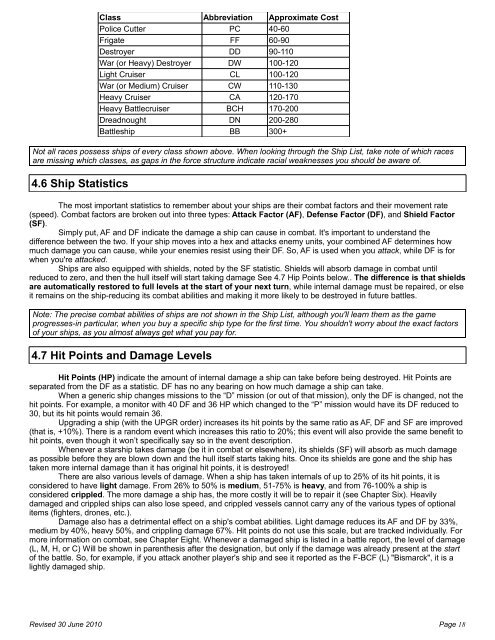Star Fleet Warlord Rules (Updated) - Play By E-Mail
Star Fleet Warlord Rules (Updated) - Play By E-Mail
Star Fleet Warlord Rules (Updated) - Play By E-Mail
You also want an ePaper? Increase the reach of your titles
YUMPU automatically turns print PDFs into web optimized ePapers that Google loves.
Class Abbreviation Approximate Cost<br />
Police Cutter PC 40-60<br />
Frigate FF 60-90<br />
Destroyer DD 90-110<br />
War (or Heavy) Destroyer DW 100-120<br />
Light Cruiser CL 100-120<br />
War (or Medium) Cruiser CW 110-130<br />
Heavy Cruiser CA 120-170<br />
Heavy Battlecruiser BCH 170-200<br />
Dreadnought DN 200-280<br />
Battleship BB 300+<br />
Not all races possess ships of every class shown above. When looking through the Ship List, take note of which races<br />
are missing which classes, as gaps in the force structure indicate racial weaknesses you should be aware of.<br />
4.6 Ship Statistics<br />
The most important statistics to remember about your ships are their combat factors and their movement rate<br />
(speed). Combat factors are broken out into three types: Attack Factor (AF), Defense Factor (DF), and Shield Factor<br />
(SF).<br />
Simply put, AF and DF indicate the damage a ship can cause in combat. It's important to understand the<br />
difference between the two. If your ship moves into a hex and attacks enemy units, your combined AF determines how<br />
much damage you can cause, while your enemies resist using their DF. So, AF is used when you attack, while DF is for<br />
when you're attacked.<br />
Ships are also equipped with shields, noted by the SF statistic. Shields will absorb damage in combat until<br />
reduced to zero, and then the hull itself will start taking damage See 4.7 Hip Points below.. The difference is that shields<br />
are automatically restored to full levels at the start of your next turn, while internal damage must be repaired, or else<br />
it remains on the ship-reducing its combat abilities and making it more likely to be destroyed in future battles.<br />
Note: The precise combat abilities of ships are not shown in the Ship List, although you'll learn them as the game<br />
progresses-in particular, when you buy a specific ship type for the first time. You shouldn't worry about the exact factors<br />
of your ships, as you almost always get what you pay for.<br />
4.7 Hit Points and Damage Levels<br />
Hit Points (HP) indicate the amount of internal damage a ship can take before being destroyed. Hit Points are<br />
separated from the DF as a statistic. DF has no any bearing on how much damage a ship can take.<br />
When a generic ship changes missions to the “D” mission (or out of that mission), only the DF is changed, not the<br />
hit points. For example, a monitor with 40 DF and 36 HP which changed to the “P” mission would have its DF reduced to<br />
30, but its hit points would remain 36.<br />
Upgrading a ship (with the UPGR order) increases its hit points by the same ratio as AF, DF and SF are improved<br />
(that is, +10%). There is a random event which increases this ratio to 20%; this event will also provide the same benefit to<br />
hit points, even though it won’t specifically say so in the event description.<br />
Whenever a starship takes damage (be it in combat or elsewhere), its shields (SF) will absorb as much damage<br />
as possible before they are blown down and the hull itself starts taking hits. Once its shields are gone and the ship has<br />
taken more internal damage than it has original hit points, it is destroyed!<br />
There are also various levels of damage. When a ship has taken internals of up to 25% of its hit points, it is<br />
considered to have light damage. From 26% to 50% is medium, 51-75% is heavy, and from 76-100% a ship is<br />
considered crippled. The more damage a ship has, the more costly it will be to repair it (see Chapter Six). Heavily<br />
damaged and crippled ships can also lose speed, and crippled vessels cannot carry any of the various types of optional<br />
items (fighters, drones, etc.).<br />
Damage also has a detrimental effect on a ship's combat abilities. Light damage reduces its AF and DF by 33%,<br />
medium by 40%, heavy 50%, and crippling damage 67%. Hit points do not use this scale, but are tracked individually. For<br />
more information on combat, see Chapter Eight. Whenever a damaged ship is listed in a battle report, the level of damage<br />
(L, M, H, or C) Will be shown in parenthesis after the designation, but only if the damage was already present at the start<br />
of the battle. So, for example, if you attack another player's ship and see it reported as the F-BCF (L) "Bismarck", it is a<br />
lightly damaged ship.<br />
Revised 30 June 2010 Page 18


